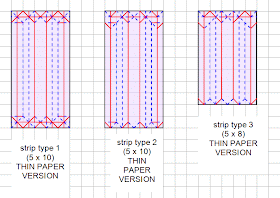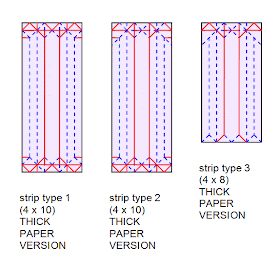
Here is a sample of another type of paper connection. It is similar to, but different from, a recent model in this blog.
I intend to post a crease pattern for the units some time soon. Unfortunately, the Silly Season is eating into my blog preparation. I promise only that you will get them when I post them.
The unit connections are sturdy, reasonably quick and decorative. The main failing is that instructions for the unit connections will not be easy to diagram. I am not looking forward to that task.

In cases like these, access to a 3-D version of the units and a 3-D example of connected units would probably be much easier to follow than traditional diagrams.
"Step folds" are another good way of showing how the method is done. As some of you already know, I arrive at conventions with "teaching boxes" containing sets of step folds which can be turned over and around by the student folder. According to the feedback I receive, these are quite useful.
It is possible that a good video clip would explain the method as well. Unfortunately these are time consuming and hard to develop. There is no shortage of excellent examples of horrific how-to-fold videos on the net. They suffer from a variety of problems including distracting backgrounds, bad choice of table top or cloth, poor illumination, poor framing of object, object partially or totally out of range of the camera, object too small or too large, angle of view unhelpful or confusing, annoying sound or music, inadequate, inappropriate or unnecessary verbal instructions and colors which are garish or insufficiently contrastive for the medium.
Exceptions, such as instructional videos made by Michael La Fosse, are a joy to watch. I am under no illusion that countering the usual problems takes quite a lot of time and effort and probably the presence of good video equipment, expensive lighting and a suitable uncluttered space. I would have a hard time matching such expertise but one day I might try.







































































